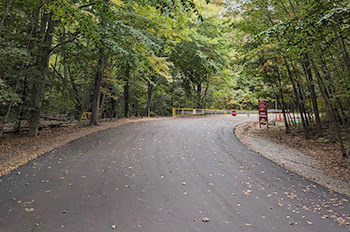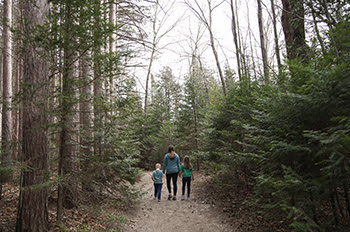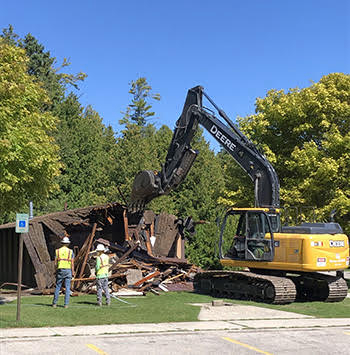Michigan: DNR’s Next Round of ARPA-Funded State Park Projects Totals More Than $108 Million
Those who regularly spend time in Michigan state parks, trails and waterways know there is a lot to love: beautiful, natural spaces, room to roam, historic sites and so much more. With the Michigan Department of Natural Resources’ second round of infrastructure projects starting to take shape, there is even more to look forward to – courtesy of record-breaking federal funding.
A total of $250 million in federal relief funding was made available to the DNR to help address its long list of critical needs in Michigan state parks. These American Rescue Plan Act funds are part of a $4.8 billion infrastructure package signed in March 2022 as part of Gov. Gretchen Whitmer’s Building Michigan Together Plan.
“Michigan’s beautiful, award-winning state parks are the backdrop of countless memories for millions of people every year,” said Gov. Whitmer. “In April, I was proud to work across the aisle and sign the Building Michigan Together Plan, which made the largest investment ever in our state and local parks. The plan will fund improvements, renovations and upgrades, ensuring our parks remain great places to visit and continue to support tens of thousands of jobs and countless local economies. Pure Michigan is anchored by our state parks, and I will work with anyone to keep investing in them and powering tourism and recreation small businesses across the state. Let’s keep working together to ensure our public parks can thrive for generations.”
DNR Director Dan Eichinger said the federal relief funding is nothing short of a historic investment in Michigan’s state parks and recreation system.
“Our staff puts in a tremendous effort to keep things running efficiently and offer quality outdoor experiences for everyone, but it has been a challenge, especially as we welcome record numbers of visitors,” said DNR Director Dan Eichinger. “This is an unprecedented, one-time funding wave that allows us to direct vital resources toward a decades-long backlog of repair and maintenance needs.”
This round includes more than a hundred projects, bundled into 40 contracts, for a proposed investment of $108.8 million. The funds will cover design, engineering and some construction. All projects, where possible, are sustainably designed to be environmentally sensitive and cost-efficient.
For ease in reporting and sharing information with the public, the DNR has grouped these ARPA-funded projects into seven broad investment categories. A few of the planned projects in each category also are identified below.
- Building projects
- Historical projects
- Major developments
- Operational structures
- Parking lots and roads
- Recreational structures
- Utilities
Building projects
Such work typically includes efforts to ensure that structures – picnic shelters and beach houses, day-use buildings, toilet and shower buildings – are increasingly more accessible and updated with the clean, modern, home-away-from-home amenities and comforts that campers and daily visitors expect. These 29 projects include:
- Cheboygan State Park (Cheboygan County): Replace campground toilet and shower building.
- Interlochen State Park (Grand Traverse County): Modernize and improve accessibility in park’s day-use building.
- Muskegon State Park (Muskegon County): Modernize beach building in day-use area.
Historical projects
To help visitors gain a sense of place and a connection to the past, historical projects are an important preservation tool and generally include structural and aesthetic improvements to buildings with historical significance. The two projects in this round include:
- Hartwick Pines State Park (Crawford County): Renovate and help preserve historic Memorial Building.
- Ionia Recreation Area (Ionia County): Renovate and help preserve the historic Sessions Schoolhouse building.
Major developments
These are larger-scale projects at a facility, often combining multiple components from the other, more targeted improvement categories. An example of a major development project would be a collection of renovations (new electrical, roads and toilet and shower buildings) at a campground loop. A total of six projects includes:
- Keith J. Charters Traverse City State Park (Grand Traverse County): Redesign and redevelop day-use area (beach front). Improve park entrance, contact station, sanitation station, vehicular circulation and accessibility.
- Young State Park (Charlevoix County): Modernize the Spruce campground with stormwater system improvements, road redevelopment and refresh of campsites.
Operational structures
Operational structures are critical connection points for the support and maintenance of parks and recreation facilities. Investments in these structures support campground amenities like sanitation stations (RV pump-out) and lift stations that remove waste from where people recreate, and water control structures (or dams) that provide beautiful lakes for fishing, boating and swimming. These 15 projects include:
- Dam repairs at Bald Mountain Recreation Area and Holly Recreation Area (Oakland County), Metamora-Hadley Recreation Area (Lapeer County) and Brighton Recreation Area (Livingston County).
- Sanitation station enhancements at Hoeft State Park (Presque Isle County), Algonac State Park (St. Clair County), Pinckney Recreation Area (Washtenaw and Livingston counties) and Hoffmaster State Park (Muskegon County).
Parking lots and roads
Parking lot and road projects involve the preventive maintenance, repair or replacement of internal park roads and parking areas. These projects help improve the visitor experience by eliminating potholes, creating a smoother ride and providing better turning capabilities for larger vehicles. These 16 projects include:
- Locations in Mitchell State Park (Wexford County), Port Crescent State Park (Huron County), Island Lake Recreation Area (Livingston County) and Sleepy Hollow State Park (Clinton County).
Recreational structures
Investments in recreational structures like boardwalks, observation decks and fishing piers ensure broader, safer access to the beaches, playgrounds, lakes and other outdoor areas campers and day-use visitors want to enjoy. These eight projects include:
- Rifle River Recreation Area (Ogemaw County): Rehabilitate and replace cable pedestrian suspension bridge and observation tower.
- Van Buren State Park (Van Buren County): Redevelop beach access due to erosion from high lake levels.
- Waterloo Recreation Area (Jackson and Washtenaw counties): Replace the fishing pier with more universally accessible features in the Portage Lake Campground. The project includes a federal grant and state fund match.
Utilities
The repair or replacement of utility systems such as water, sanitary and electrical systems may not be as visible as other efforts, but they are necessary to both meet modern health and safety requirements and serve visitors’ evolving needs and comfort expectations. These 38 projects include:
- Bewabic State Park (Iron County): Repair or replace on-site wastewater treatment facility for campground toilet and shower buildings and sanitation station.
- Clear Lake State Park (Montmorency County): Modernize campground sanitary system and lift station.
- Port Crescent State Park (Huron County): Replace and modernize existing water, sewer and electrical systems throughout the park and replace or repair campground roads.
- Tawas Point State Park (Iosco County): Replace and modernize campground electrical system.
Looking ahead
DNR Parks and Recreation Chief Ron Olson said it’s an all-hands-on-deck effort to move these projects through a thoughtful design and engineering phase, followed by bid letting and construction. It’s a process involving multiple agencies, including the Michigan departments of Environment, Great Lakes, and Energy; Technology, Management and Budget; and Transportation.
“This is a massive team effort,” Olson said. “Because we already had a pretty solid understanding of the many maintenance, repair and development projects we knew we wanted to accomplish – and some of that work was ongoing through normal operations – the influx of ARPA funding meant we had to work together, quickly, to prioritize which projects were most critical or nearest to implementation.”
Olson said the first round of projects (announced in June), includes 11 “shovel ready projects.” The first two projects at Straits and Cheboygan state parks will break ground as early as this fall. In future years, additional state park funding will help cover construction costs not addressed with this ARPA investment.
Additionally:
- ARPA funding also includes up to $30.2 million to develop a new state park in Flint.
- The third and final round of projects, to be announced later this year, includes projects that have already started in some form but require additional investment for completion. This includes $37.8 million for trails projects across the state, the majority of which have not yet been announced.
Federal funding requirements state that ARPA funds must be obligated (committed to a project) by Dec. 31, 2024, and spent on that project by Dec. 31, 2026.
Follow our progress
To help the public and media stay up to date on these projects and learn more about the funding and decision-making, the DNR has created a website at Michigan.gov/StateParksProgress, which includes:
- An interactive map identifying proposed project locations and details, including status (proposed, design/bid phase, construction started or project completed) of each project. (Please note: This map is specific to ARPA-funded projects; it does not include the variety of other work happening at state parks, trails and waterways.)
- Frequently asked questions.
- State parks facts.
- An evolving photo gallery, including many examples of the work needing to be done. As projects are completed, “after” photos will be added.
The Michigan Department of Natural Resources is committed to the conservation, protection, management, use and enjoyment of the state’s natural and cultural resources for current and future generations. For more information, go to Michigan.gov/DNR.






